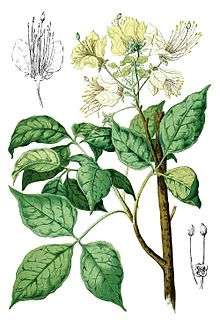Crateva religiosa
Crateva religiosa, the sacred garlic pear or temple plant, is a species of flowering tree. It is a member of the capers family. The tree is sometimes called the spider tree because the showy flowers bear long, spidery stamens. It is native to Japan, Australia, much of Southeast Asia and several South Pacific islands. It is grown elsewhere for fruit, especially in parts of the African continent.
| Crateva religiosa | |
|---|---|
 | |
| Scientific classification | |
| Kingdom: | Plantae |
| Clade: | Tracheophytes |
| Clade: | Angiosperms |
| Clade: | Eudicots |
| Clade: | Rosids |
| Order: | Brassicales |
| Family: | Capparaceae |
| Genus: | Crateva |
| Species: | C. religiosa |
| Binomial name | |
| Crateva religiosa | |
| Synonyms | |
| |
The fruit of the tree is edible and high in vitamin C. The nectar-filled flowers are attractive to a multitude of insects and birds. A pierid butterfly, Hebomoia glaucippe, is a frequent visitor to this plant.
The garlic pear tree is a perennial that can grow up to 15 m (49 ft).
Lupeol, a extract derived from the bark of C. Religiosa, can be used as an anti-inflammatory agent.[1] Lupeol is also found to promote the generation of the epidermal layer and antioxidant enzymes in which both aid in replenishing the human skin.[2]
References
- Patil, Udaysing; D.K, Gaikwad (2011). "Medicinal Profile of a Scared Drug in Ayurveda: Crataeva Religiosa". Journal of Pharmaceutical Science and Research. 3: 923–929. S2CID 212558106.
- Tchimene, Michel; Nwaehujor, Chinaka; Ezenwali, Moses; Okoli, Charles; Iwu, Maurice (2016). "Free Radical Scavenging Activity of Lupeol Isolated from the Methanol Leaf Extract of Crateva Adansonii Oliv. (Capparidaceae)". International Journal of Pharmacognosy and Phytochemical Research. 8: 419–426.